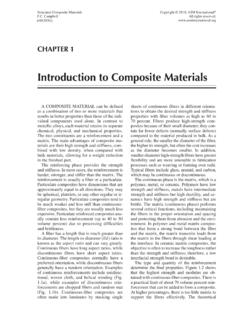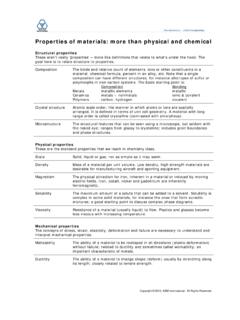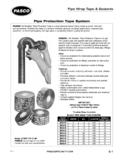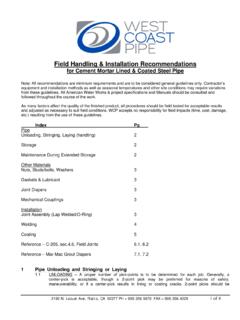Transcription of External Corrosion of Oil and Natural Gas Pipelines
1 External Corrosion ofOil and Natural Gas PipelinesJohn A. Beavers and Neil G. Thompson, CC TechnologiesPIPELINES play an extremely important rolethroughout the world as a means of transportinggases and liquids over long distances from theirsources to the ultimate consumers. The generalpublic is not aware of the number of pipelinesthat are continually in service as a primary meansof transportation. A buried operating pipeline israther unobtrusive and rarely makes its presenceknown except at valves, pumping or compressorstations, or terminals. In the United States, therewere approximately 217,000 km (135,000 mi)of hazardous liquid transmission Pipelines ,34,000 km (21,000 mi) of crude oil gatheringpipelines, 483,000 km (300,000 mi) of naturalgas transmission Pipelines , and 45,000 km(28,000 mi) of Natural gas gathering Pipelines in2000 (Ref 1 3).
2 There were approximately 60major Natural gas transmission pipeline opera-tors and 150 major hazardous liquid pipelineoperators in the United States in 1998 (Ref 4).The first oil pipeline, which was 175 km(109 mi) in length and 152 mm (6 in.) in dia-meter, was laid from Bradford to Allentown, PAin 1879 (Ref 5). Since the late 1920s, virtually alloil and gas Pipelines have been made of weldedsteel. Although the first cross-country pipelinethat connected some major cities was laid in1930, it was not until World War II that large-scale Pipelines were laid connecting differentregions of the country.
3 In the 1960s, larger-diameter Pipelines ranging from 813 to 914 mm(32 to 36 in.) were built. Discovery of oil onAlaska s North Slope resulted in the constructionof the country s largest pipeline, the Trans-AlaskaPipeline System, with a 1219 mm (48 in.)diameter and 1287 km (800 mi) length. Demandcontinues to add more miles of 1 provides a summary of the majoraccidents reported to the Department ofTransportation by the operators for the 6-yearperiod between 1994 and 1999 (Ref 6). The datashow that for transmission pipeline systems (bothhazardous liquid and Natural gas), approximately25% of all reported accidents were due to corro-sion.
4 Of the hazardous liquid pipeline accidentscaused by Corrosion , 65% were due to externalcorrosion and 34% were due to internal Natural gas transmission pipeline accidents,36% were caused by External Corrosion and 63%were caused by internal Corrosion . For Natural gasdistribution pipeline accidents, only approxi-mately 4% of the total accidents were caused bycorrosion, and the majority of those were causedby External Corrosion . The accidents reported inTable 1 are for major accidents that resulted ininjury, fatality, or more than $50,000 in propertydamage. In addition to the reportable accidents,an average of 8000 Corrosion leaks per year arerepaired on Natural gas transmission Pipelines (Ref 7), and 1600 spills per year are repaired andcleaned up for liquid product a summary report for incidents between1985 and 1994, Corrosion accounted for ofpipeline incidents on Natural gas transmissionand gathering Pipelines (Ref 8).
5 In a summaryreport for incidents between 1986 and 1996, Corrosion accounted for of pipeline inci-dents on hazardous liquid Pipelines (Ref 9).These values correspond very well to the statis-tics for 1994 to 1999 presented in Table the implications of pipeline failures andthe role that External Corrosion plays in thesefailures, it is apparent that proper corrosioncontrol can have a major impact on the safety,environmental preservation, and the economicsof pipeline vast majority of underground Pipelines aremade of carbon steel, based on American Petro-leum Institute API 5L specifications (Ref 10).
6 Typically, maximum composition limits arespecified for carbon, manganese, phosphorous,and sulfur. In some cases, other alloying elementsare added to improve mechanical and tensile requirements forcommon line pipe steels are shown in Table steels have inadequate alloy additionsto be considered Corrosion resistant and undergoTable 1 Summary of Corrosion -relatedaccident reports on hazardous liquid, naturalgas transmission, and Natural gas distributionpipelines from 1994 to 1999 CategoryPipeline system typeHazardous liquidtransmissionNatural gastransmissionNatural gasdistributionTotal accidentsdue tocorrosion(1994 1999)27111426 Total accidents(1994 1999)
7 1116448708 Total accidentsdue tocorrosion, % due toexternalcorrosion, % due tointernalcorrosion, % causenot specified, % : Ref 6 Table 2 Chemical and tensile requirements of common long seam welded line pipe steelsGradeComposition, wt% maxYield strength minimumUltimate tensile specification level 1, Ref 10 2006 ASM International. All Rights Handbook, Volume 13C, Corrosion : Environments and Industries (#05145) variety of Corrosion failure modes/mechanismsin underground environments, including generalcorrosion, pitting Corrosion , and stress-corrosioncracking (SCC).
8 The terms general Corrosion and pittingcorrosion are used rather loosely when de-scribing the morphology of underground corro-sion. The classical pitting often associatedwith passive metals (such as stainless steels) istypically not observed on underground Pipelines ,with the possible exception of cases wheremicrobial activity is involved. Likewise, truegeneral Corrosion , where there is uniform metalloss, such as observed with carbon steel in aconcentrated acid, is not commonly found onunderground Pipelines . The most commonmorphology of Corrosion on underground pipe-lines is uneven metal loss over localized areascovering a few to several hundred square inches(Fig.)
9 1). The most common mechanism causingthis Corrosion is referred to as differentialcorrosion cells. Microbes and stray direct current(dc) in the soil also can affect of the relatively poor corrosionresistance of line pipe steels in undergroundenvironments, a combination of mitigationstrategies consisting of coatings and cathodicprotection (CP) is required. In this article, themost common causes and contributing factorsfor Corrosion and SCC, as well as prevention,mitigation, detection, and repair are Cell CorrosionIn the case of true general Corrosion of a metal,the oxidation and reduction reactions occurphysically at or very near the same location on ametal.
10 At any given moment, one atom is beingoxidized while the reduction reaction is occur-ring at an adjacent atomic site. Corrosion of ametal in an acid solution is a common example ofthis type of behavior. It is also possible for theoxidation and reduction reactions to be separatedon a metal surface, where the metal oxidationoccurs predominantly at one site while thereduction reaction occurs predominantly atanother site. This is referred to as a differentialcorrosion cell. Underground Corrosion of pipe-lines and other structures is often the result ofdifferential Corrosion cells of which a variety ofdifferent types exist.


















